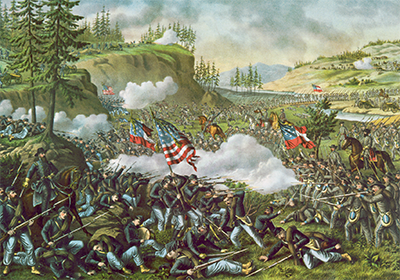Union General William S. Rosencrans
William S. Rosencrans was a Union general during the American Civil War. He is most well-known for his victory at the Battle of Stones River and his defeat the Battle of Chickamauga. 
He was born on Sept. 6, 1819, at Little Taylor Run, in Delaware County, Ohio. Largely self-educated, he found work as a store clerk as early as 13 and won an appointment to the U.S. Military Academy in 1838. He excelled in his studies (earning him the moniker "Old Rosy") at West Point and graduated in with a commission as a brevet second lieutenant in the Corps of Engineers. About the same time, he married Eliza Hegeman; the couple had eight children. His first posting was to Fort Monroe, in Virginia. He served a year there and then went back to West Point, to each engineering. He stayed at West Point during the Mexican-American War and performed engineering work in Rhode Island, Massachusetts, and at the Washington Naval Yard. He applied to teach at the Virginia Military Institute in 1851 but was passed over in favor of Stonewall Jackson. Rosencrans suffered ill health and, in 1854, resigned his Army commission to work in the private sector, at a Virginia mining company. As owner of the Preston Coal Oil Company, he suffered severe burns in a refinery fire and spent one-and-one-half years recovering. When the Civil War started, Rosencrans found assignment on the staff of then-Department of Ohio Commander George McClellan. Rosencrans gained command of an Ohio infantry force for a time and won promotion to the rank of brigadier general, gaining distinction in the Union victory at Rich Mountain, in western Virginia. Replacing McClellan atop the Army of Occupation, he led Union troops in successful action elsewhere in western Virginia and then achieved a transfer to the West. 
Rosencrans commanded troops at the Battle of Iuka and the Battle of Corinth and then won promotion to major general and command of the Army of the Cumberland, on Oct. 30, 1862. This army engaged Confederate forces in Tennessee and Georgia, at Stones River and Chickamauga and Chattanooga. The Battle of Stones River, in late 1862, ended in a Union victory, driving the Army of Tennessee under Gen. Braxton Bragg out of Murfreesboro. Further Union action during the Tullahoma Campaign the following summer drove the Confederates into Georgia, where the Battle of Chickamauga was fought. 
On four days in September 1863, Rosencrans and Bragg threw troops at each other. In a critical moment on the fourth day, Rosencrans sent a number of his troops to fill a nonexistent gap in the line and Bragg's men crashed through, sending Rosencrans and much of his army reeling from the battlefield. Only a heroic stand on Horseshoe Ridge (also known as Snodgrass Hill) by Gen. George Thomas and his men saved the Union actions from dissolving into chaos. (For his actions, Thomas earned the moniker the "Rock of Chickamauga.") Less than a month later, Thomas replaced Rosencrans as leader of the Army of the Cumberland. Rosencrans commanded the Department of Missouri for most of 1864 but did not receive another appointment. He resigned his commission in 1867 and moved to California. He served as Ambassador to Mexico for a time and then won election to the U.S. House of Representatives in 1880. Among his responsibilities was chair of the Military Affairs Committee. He left Congress after two terms to work as Register of the Treasury, a job he had until 1893. He later refused appeals from the Democratic Party to run for office at both the state and the federal level, preferring to keep his business options open, and his detractors named him "the Great Decliner." His wife died in 1883. He died on March 11, 1898, in Redondo Beach, Calif. |
|
Social Studies for Kids
copyright 2002–2025
David White




